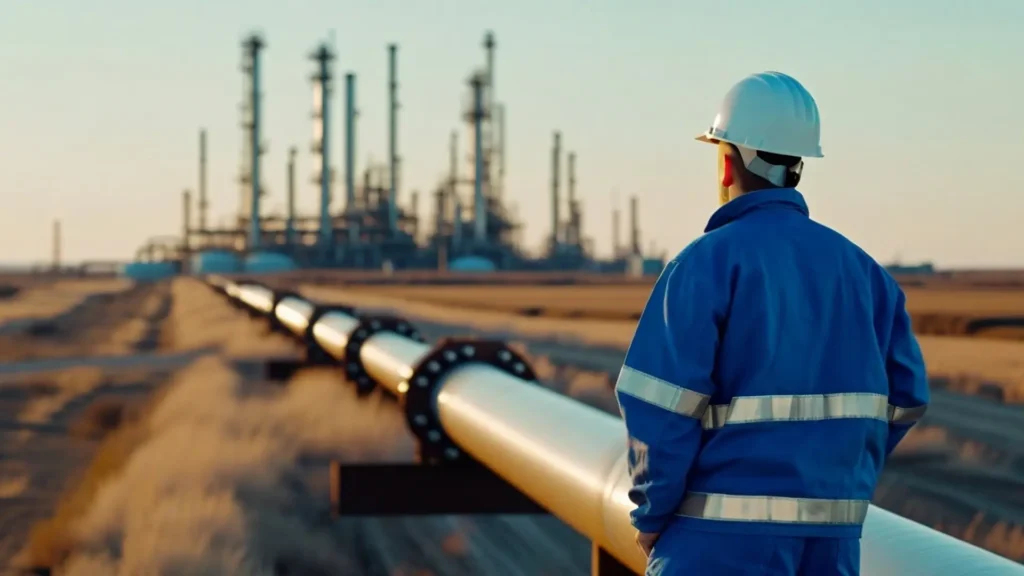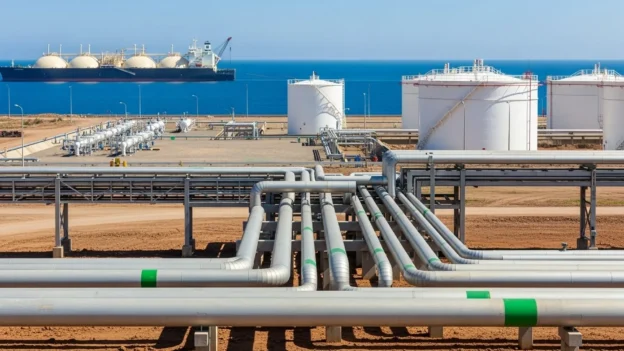Table of Contents
- Asset management and reliability in midstream networks
- Operational risks and response plans for pipelines
- Critical performance metrics for assessing integrity
- Integration of ESG practices in the midstream sector
- Establishment of a Safety Management System (SMS)
- Main API standards applicable to midstream pipelines
- API 1173 approach to operations and maintenance
- Specialist competencies and practical application
- Benefits and best practices
- Keys to effective implementation
- Conclusions
- References
Midstream pipeline networks are essential for transporting hydrocarbons and gases in the energy value chain. These infrastructures enable large volumes of products to be moved continuously, safely, and efficiently, connecting production centers with refining, processing, and distribution facilities.
However, their operation requires a rigorous approach to operations and maintenance management, as any failure impacts not only the continuity of supply, but also the safety of communities and environmental sustainability. Operations and maintenance management in midstream pipeline networks integrates disciplines of engineering, reliability, asset management, and mechanical integrity. Its purpose is to maximize availability, reduce risks, and ensure compliance with international standards.
This article is intended for engineers and technicians specializing in mechanical integrity and pipeline inspection, with the aim of providing a technical, professional, and up-to-date overview of the main challenges and guidelines that guide the industry.
Asset management and reliability in midstream networks
Asset management in midstream networks focuses on comprehensively managing the life cycle of multi-product pipeline infrastructure. This involves planning, operating, maintaining, and eventually replacing equipment in a way that optimizes availability and minimizes risk-related costs. An example of this is inspection to verify the operational status of a pipeline to a petrochemical plant and infrastructure in an energy transport area with complex industrial systems.

One of the pillars is Operational Reliability, which allows maintenance activities to be prioritized according to the criticality of each section of pipeline. For example, an oil pipeline exposed to unstable geotechnical conditions will receive more preventive attention than one on stable ground.
Digitization has transformed this management through the use of digital twins, SCADA systems, and Asset Performance Management (APM) platforms. These tools allow for modeling deterioration scenarios, predicting failures, and optimizing resources to extend the useful life of assets.
Operational risks and response plans for pipelines
The operation of multi-purpose pipelines is exposed to significant risks that must be managed systematically. Among the main ones are:
- Internal and external corrosion.
- Damage caused by third parties. – Leaks and ruptures.
- Geotechnical threats (landslides, floods, earthquakes).
Table 1. Risk mitigation strategies.
| Identified Risk | Mitigation Strategy |
|---|---|
| Internal Corrosion | Chemical inhibitors, cleaning pigging |
| External Corrosion | Cathodic protection, advanced coatings |
| Third-Party Damage | Third-party monitoring, signage, aerial patrol |
| Geotechnical Threats | Geotechnical monitoring, early warning systems |
| Leaks/Ruptures | Sectionalizing valves, emergency response plans |
Risk analysis in pipelines is carried out using methodologies such as Quantitative Risk Assessment (QRA), which combines probability and consequences to establish priorities. It is therefore necessary to design mitigation strategies such as advanced coatings, cathodic protection, automated shut-off valves, and continuous monitoring using fiber optics or sensors.
In terms of response plans, coordination with local authorities, emergency brigades, and nearby communities is essential. Protocols should include planned drills, evacuation routes, isolation of critical sections, and immediate communication with regulatory agencies.
Critical performance metrics for assessing integrity
The integrity of pipelines cannot be assessed without quantifiable indicators that measure performance and risks. Some of the most relevant metrics are:
- Operational availability (% of system uptime).
- Mean Time Between Failures (MTBF): average time between failures.
- Mean Time To Repair (MTTR): average repair time.
- Corrosion rate (loss of thickness in mm/year).
- Number of reportable incidents (according to regulations such as PHMSA or API 1160).
Table 2. Risk Classification in Midstream Pipelines
| Risk Category | Probability | Consequence | Risk Level |
|---|---|---|---|
| Internal Corrosion | High | Medium | High |
| External Corrosion | Medium | High | High |
| Third-Party Damage | Medium | High | Critical |
| Geotechnical Threats | Low–Medium | Very High | Critical |
| Leaks/Ruptures | Low | Very High | Critical |
Monitoring these indicators not only strengthens reliability, but also allows the effectiveness of integrity programs to be justified to investors and regulators.
Integration of ESG practices in the midstream sector
The midstream sector, traditionally focused on hydrocarbon transportation, now faces the challenge of integrating environmental, social, and governance (ESG) criteria into its operations.
- Environmental: reduction of fugitive emissions of methane and volatile organic compounds (VOCs), implementation of early detection technologies, and energy efficiency projects.
- Social: social responsibility programs with local communities, job creation, and training plans.
- Senior management: strict compliance with regulations, external audits, and transparent performance reports.
ESG integration is not only a regulatory obligation, but also a competitive differentiator that improves social acceptance of projects and facilitates access to sustainable financing.
Establishment of a Safety Management System (SMS)
An SMS is a structured tool that has proven effective in numerous cases in reducing human error, creating a culture of safety at all levels of the organization, and decreasing the likelihood of maritime accidents. The objectives of an SMS are to provide safe working practices for pipeline network operations and maintenance, continuously assess and identify risks to the pipeline, personnel, and the environment, establish appropriate protective measures for those risks. They also aim to improve the safety management skills of personnel responsible for operations and maintenance.
Main API standards applicable to midstream pipelines
The management of pipeline operations and maintenance is governed by international standards, including:
- API 1160: Pipeline Integrity Management.
- API 1160 is a recommended practice applicable to pipeline systems used to transport “hazardous liquids” as defined in Title 49 of the U.S. CFR, Part 195.2.
- The use of this recommended practice is not limited to pipelines regulated by 49 CFR 195, and the principles incorporated in integrity management are applicable to all pipeline systems.
- API 1104: Welding requirements for pipelines and associated equipment.
- API RP 1110: Safe operating pressure in pipelines.
- API 579 / ASME FFS-1: Fitness-for-Service evaluation.
These standards are complemented by local regulations, such as those issued by PHMSA in the US or gas and oil transportation regulations in Latin America. Compliance with these standards is essential to ensure the integrity and sustainability of assets.
API 1173 approach to operations and maintenance
The API 1173 standard (Pipeline Safety Management System, PSMS) is essential for pipeline and gas pipeline operations and maintenance specialists, as it establishes a structured framework for managing safety, optimizing processes, and minimizing operational risks. Developed by the American Petroleum Institute (API), it is a framework for the Pipeline Safety Management System (PSMS). It was created in collaboration with the National Transportation Safety Board (NTSB) and other industry stakeholders. The goal is to improve safety, reduce risks, and encourage continuous improvement in pipeline operations and maintenance.
API 1173 provides a structure based on continuous improvement, risk management, and process documentation for all phases of pipeline operation.
- The standard is adaptive and applicable to both small businesses and large corporations.
- It promotes the integration of leadership, organizational culture, change management, and technical skills development among personnel responsible for operations and maintenance.
- The management cycle is based on the Plan-Do-Check-Act model: planning, executing controls and training, reviewing incidents, and continuously correcting processes.
This standard offers a voluntary and adaptable safety management system for pipeline operators of all sizes. It covers the design, installation, operation, maintenance, and integrity of pipelines. While not a legal requirement, it is widely recommended by industry leaders and regulatory agencies. Compliance can help prevent accidents, reduce risks, and protect both the population and the environment.
Specialist competencies and practical application
A specialist must master:
- Identification, assessment, and mitigation of risks associated with pipeline operation and maintenance.
- Implementation of training programs aligned with API 1173 to ensure that all personnel are qualified and up to date on safe procedures and emergencies.
- Use of internal assessments, audits, and gap analyses to improve the management system, adjusting procedures and operational practices to the requirements of the standard.
- Documentation and control of operational records, both in procedures and incidents, to facilitate audits and regulatory reviews.
- Effective change management: ensuring that any technical, operational, or administrative modification is planned, evaluated, and accepted under the proposed safety framework.
- Promoting and fostering a culture of safety and organizational learning so that errors and incidents are systematically investigated and used to improve the system.
Benefits and best practices
Properly implementing API 1173 allows you to:
- Reduce operational incidents, leaks, and environmental risks.
- Optimize costs by preventing failures and regulatory penalties.
- Strengthen trust and reputation with regulators and the community by demonstrating a commitment to safety and responsible management.
- Align with regulations from agencies such as PHMSA and OSHA, avoiding legal and financial penalties.
Keys to effective implementation
A specialist should:
- Conduct gap analyses to identify strengths and areas for improvement.
- Design comprehensive training programs with modules on risk management, emergency response, and practical case studies.
- Use mixed training methods: face-to-face classes, online courses, and practical simulations.
- Establish key performance indicators and create mechanisms for feedback and continuous improvement.
Conclusions
Operations and maintenance management in midstream networks is an important pillar for ensuring the reliability, safety, and sustainability of energy infrastructure. Through the application of asset management strategies, risk mitigation plans, performance metrics, and compliance with API standards, mechanical integrity engineers ensure operational continuity and environmental protection.
In a context of energy transition and growing social demands, ESG practices are an indispensable layer in pipeline management. In this way, the midstream sector not only transports energy, but also drives sustainable development and stakeholder confidence.
The future of pipeline operations and maintenance will depend on the ability to integrate technological innovation, responsible management, and strategic vision to meet the challenges of a changing energy market.
References
- https://veriforce.com/blog/api-rp-1173
- https://www.dco.uscg.mil/Portals
- https://www.ecfr.gov/current/title-49/subtitle-B/chapter-VIII
- https://www.api.org/
- https://inspenet.com/articulo/seguridad-de-oleoductos-con-api-rp-1173/

